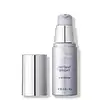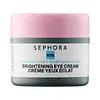What's inside
What's inside
 Key Ingredients
Key Ingredients

 Benefits
Benefits

 Concerns
Concerns

 Ingredients Side-by-side
Ingredients Side-by-side

Water
Skin ConditioningDimethicone
EmollientGlycerin
HumectantButylene Glycol
HumectantHdi/Trimethylol Hexyllactone Crosspolymer
Polysilicone-11
Ethylhexyl Olivate
Skin ConditioningBoron Nitride
AbsorbentSodium Acrylate/Sodium Acryloyldimethyl Taurate Copolymer
Emulsion StabilisingPhenylethyl Resorcinol
AntioxidantPolymethylsilsesquioxane
Phenoxyethanol
PreservativeAlbizia Julibrissin Bark Extract
MaskingDecyl Glucoside
CleansingCaffeine
Skin ConditioningIsohexadecane
EmollientVitis Vinifera Flower Cell Extract
MaskingHydroxyacetophenone
AntioxidantTrehalose
HumectantUrea
BufferingPentylene Glycol
Skin ConditioningPolysorbate 80
EmulsifyingSucrose Palmitate
EmollientSea Water
HumectantCaprylyl Glycol
EmollientSclareolide
MaskingDisodium EDTA
Tromethamine
BufferingDiethylhexyl Syringylidenemalonate
Skin ProtectingEthylhexylglycerin
Skin ConditioningSqualane
EmollientTocopheryl Acetate
AntioxidantPolysorbate 60
EmulsifyingSilica
AbrasiveSerine
MaskingLecithin
EmollientSucrose
HumectantPlankton Extract
Skin ConditioningPropanediol
SolventSodium Hyaluronate
HumectantAlteromonas Ferment Extract
Skin ConditioningSodium Hyaluronate Crosspolymer
HumectantSodium Chloride
MaskingPullulan
Disodium Phosphate
BufferingAlgin
MaskingGlyceryl Polyacrylate
Hydrolyzed Hyaluronic Acid
HumectantCaprylic/Capric Triglyceride
MaskingPorphyridium Cruentum Extract
Skin ConditioningPotassium Sorbate
PreservativePotassium Phosphate
BufferingSigesbeckia Orientalis Extract
Skin ConditioningCitric Acid
BufferingWater, Dimethicone, Glycerin, Butylene Glycol, Hdi/Trimethylol Hexyllactone Crosspolymer, Polysilicone-11, Ethylhexyl Olivate, Boron Nitride, Sodium Acrylate/Sodium Acryloyldimethyl Taurate Copolymer, Phenylethyl Resorcinol, Polymethylsilsesquioxane, Phenoxyethanol, Albizia Julibrissin Bark Extract, Decyl Glucoside, Caffeine, Isohexadecane, Vitis Vinifera Flower Cell Extract, Hydroxyacetophenone, Trehalose, Urea, Pentylene Glycol, Polysorbate 80, Sucrose Palmitate, Sea Water, Caprylyl Glycol, Sclareolide, Disodium EDTA, Tromethamine, Diethylhexyl Syringylidenemalonate, Ethylhexylglycerin, Squalane, Tocopheryl Acetate, Polysorbate 60, Silica, Serine, Lecithin, Sucrose, Plankton Extract, Propanediol, Sodium Hyaluronate, Alteromonas Ferment Extract, Sodium Hyaluronate Crosspolymer, Sodium Chloride, Pullulan, Disodium Phosphate, Algin, Glyceryl Polyacrylate, Hydrolyzed Hyaluronic Acid, Caprylic/Capric Triglyceride, Porphyridium Cruentum Extract, Potassium Sorbate, Potassium Phosphate, Sigesbeckia Orientalis Extract, Citric Acid
Water
Skin ConditioningCaprylic/Capric Triglyceride
MaskingGlycerin
HumectantGlyceryl Stearate Citrate
EmollientHeptyl Undecylenate
EmollientButylene Glycol
HumectantSilica
AbrasiveJojoba Esters
EmollientC10-18 Triglycerides
EmollientHydroxyethyl Acrylate/Sodium Acryloyldimethyl Taurate Copolymer
Emulsion StabilisingCaffeine
Skin ConditioningSodium Polyacrylate
AbsorbentHydroxyacetophenone
AntioxidantTocopheryl Acetate
AntioxidantCaprylyl Glycol
EmollientSodium Hyaluronate
HumectantPolysorbate 60
EmulsifyingSorbitan Isostearate
EmulsifyingPotassium Cetyl Phosphate
EmulsifyingSodium Benzoate
MaskingChlorella Vulgaris Extract
Skin ConditioningSodium Phytate
Tocopherol
AntioxidantWater, Caprylic/Capric Triglyceride, Glycerin, Glyceryl Stearate Citrate, Heptyl Undecylenate, Butylene Glycol, Silica, Jojoba Esters, C10-18 Triglycerides, Hydroxyethyl Acrylate/Sodium Acryloyldimethyl Taurate Copolymer, Caffeine, Sodium Polyacrylate, Hydroxyacetophenone, Tocopheryl Acetate, Caprylyl Glycol, Sodium Hyaluronate, Polysorbate 60, Sorbitan Isostearate, Potassium Cetyl Phosphate, Sodium Benzoate, Chlorella Vulgaris Extract, Sodium Phytate, Tocopherol
 Reviews
Reviews

Ingredients Explained
These ingredients are found in both products.
Ingredients higher up in an ingredient list are typically present in a larger amount.
Butylene Glycol (or BG) is used within cosmetic products for a few different reasons:
Overall, Butylene Glycol is a safe and well-rounded ingredient that works well with other ingredients.
Though this ingredient works well with most skin types, some people with sensitive skin may experience a reaction such as allergic rashes, closed comedones, or itchiness.
Learn more about Butylene GlycolCaffeine is most associated with coffee, tea, and cacao. In skincare, it helps with calming inflammation and is rich in antioxidants.
While caffeine is used to treat cellulite and and dark circles, further studies are needed to prove this. It has been believed to help with these skin conditions due to its ability to dilate blood vessels and increase blood flow.
Some studies are looking into caffeine's ability to protect against UV rays.
Learn more about CaffeineThis ingredient is an emollient, solvent, and texture enhancer. It is considered a skin-softener by helping the skin prevent moisture loss.
It helps thicken a product's formula and makes it easier to spread by dissolving clumping compounds.
Caprylic Triglyceride is made by combining glycerin with coconut oil, forming a clear liquid.
While there is an assumption Caprylic Triglyceride can clog pores due to it being derived from coconut oil, there is no research supporting this.
Learn more about Caprylic/Capric TriglycerideCaprylyl Glycol is a humectant and emollient, meaning it attracts and preserves moisture.
It is a common ingredient in many products, especially those designed to hydrate skin. The primary benefits are retaining moisture, skin softening, and promoting a healthy skin barrier.
Though Caprylyl Glycol is an alcohol derived from fatty acids, it is not the kind that can dry out skin.
This ingredient is also used as a preservative to extend the life of products. It has slight antimicrobial properties.
Learn more about Caprylyl GlycolGlycerin is already naturally found in your skin. It helps moisturize and protect your skin.
A study from 2016 found glycerin to be more effective as a humectant than AHAs and hyaluronic acid.
As a humectant, it helps the skin stay hydrated by pulling moisture to your skin. The low molecular weight of glycerin allows it to pull moisture into the deeper layers of your skin.
Hydrated skin improves your skin barrier; Your skin barrier helps protect against irritants and bacteria.
Glycerin has also been found to have antimicrobial and antiviral properties. Due to these properties, glycerin is often used in wound and burn treatments.
In cosmetics, glycerin is usually derived from plants such as soybean or palm. However, it can also be sourced from animals, such as tallow or animal fat.
This ingredient is organic, colorless, odorless, and non-toxic.
Glycerin is the name for this ingredient in American English. British English uses Glycerol/Glycerine.
Learn more about GlycerinHydroxyacetophenone is antioxidant with skin conditioning and soothing properties. It also boosts the efficiency of preservatives.
This ingredient is not irritating or sensitizing.
Polysorbate 60 is used to help stabilize products. It is a surfactant and emulsifier. These properties help keep ingredients together in a product. Surfactants help reduce surface tension between ingredients with different states, such as liquids and solids. Emulsifiers help prevent oils and waters from separating.
Polysorbate 60 is sorbitol-based and created from the ethoxylation of sorbitan. Ethoxylation is a chemical reaction used to add ethylene oxide. Sorbitan is a the dehydrated version of sorbitol, a sugar found in fruits.
In this case, the 60 comes from reacting 60 units of ethylene oxide with sorbitan.
Polysorbates are commonly used in medicine and foods.
Learn more about Polysorbate 60Silica, also known as silicon dioxide, is a naturally occurring mineral. It is used as a fine, spherical, and porous powder in cosmetics.
Though it has exfoliant properties, the function of silica varies depending on the product.
The unique structure of silica enhances the spreadability and adds smoothness, making it a great texture enhancer.
It is also used as an active carrier, emulsifier, and mattifier due to its ability to absorb excess oil.
In some products, tiny microneedles called spicules are made from silica or hydrolyzed sponge. When you rub them in, they lightly polish away dead skin layers and enhance the penetration of active ingredients.
Learn more about SilicaSodium Hyaluronate is hyaluronic acid's salt form. It is commonly derived from the sodium salt of hyaluronic acid.
Like hyaluronic acid, it is great at holding water and acts as a humectant. This makes it a great skin hydrating ingredient.
Sodium Hyaluronate is naturally occurring in our bodies and is mostly found in eye fluid and joints.
These are some other common types of Hyaluronic Acid:
Learn more about Sodium HyaluronateTocopheryl Acetate is AKA Vitamin E. It is an antioxidant and protects your skin from free radicals. Free radicals damage the skin by breaking down collagen.
One study found using Tocopheryl Acetate with Vitamin C decreased the number of sunburned cells.
Tocopheryl Acetate is commonly found in both skincare and dietary supplements.
Learn more about Tocopheryl AcetateWater. It's the most common cosmetic ingredient of all. You'll usually see it at the top of ingredient lists, meaning that it makes up the largest part of the product.
So why is it so popular? Water most often acts as a solvent - this means that it helps dissolve other ingredients into the formulation.
You'll also recognize water as that liquid we all need to stay alive. If you see this, drink a glass of water. Stay hydrated!
Learn more about Water